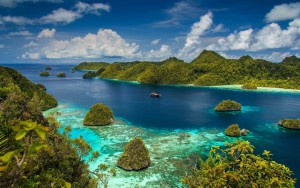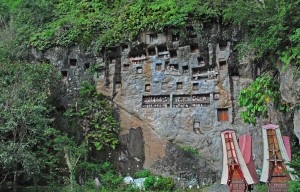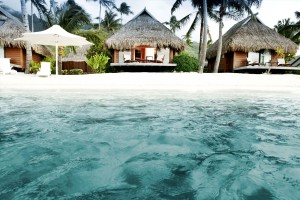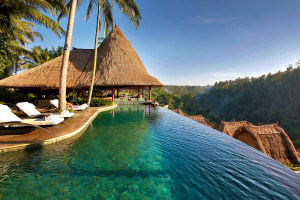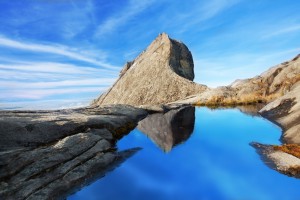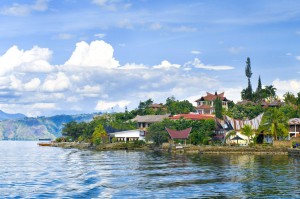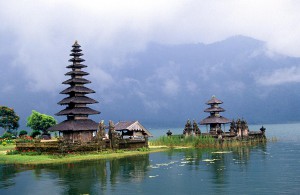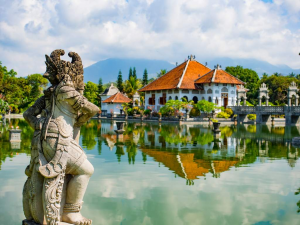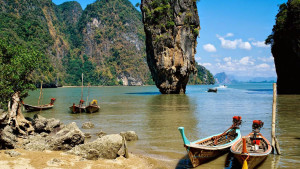Grand Java
Java is a heavily populated island of enormous diversity ranging from unspoiled tropical beaches and jungles to active volcanoes and ancient monuments.
Surrounding the nation’s capital of Jakarta on three sides, West Java provides visitors with a great number of fascinating things to see and do; get up close to the remains of the awesome Krakatau; explore the undisturbed wildlife reserve of Ujung Kulon on the south-western tip of Java; admire the Pulau Dua Bird Sanctuary off the coast of Banten and visit isolated communities of the mysterious Baduy; treasure the royal palaces of Cirebon and the world renowned botanical gardens of Bogor.
Evidence of a rich and influential history can be found all over the island, particularly in Central Java from the times of the Mataram Empire. On the part of the southern side also lies the province of Yogyakarta special region. The home to the biggest Buddhist Temple in the world is Borobudur.
Stretched to the Central and East Java, too, have an assortment of attractions, ranging from ancient temple sites to beautiful, unspoiled beaches, picturesque highland lakes, colourful marine gardens and fantastic wildlife reserves. Magnificent mountain scenery includes the crater and legendary sea of sand at Mount Bromo, the “sulphur mountain” of welirang and the rugged Ijen Plateau.
Cultural Highlights
Characteristics of Javanese culture are very complex. The island has a wide range of cultures, from the primitive, traditional, to modern. It can be mentioned here that the cultural heritage in the past are the magnificent temples, the ruins of palaces and monasteries, the various kind of traditions cultural events, traditional folk performing arts, traditional ritual ceremonies, customs, traditional handicrafts, traditional architecture and other traditional activities.
Majestic Sumatera
Sumatera is the second largest island in Indonesia and possibly one of the richest in terms of natural resources and beauty. The Bukit Barisan Mountains stretch for most of the island’s length plunging steeply to the sea in the west and rolling onto swampy plains in the east. Perfect cone-shaped volcanoes peak above thick jungles where rare Sumatran tigers, orangutan and rhinos still roam. Sculpted canyons, mighty rivers, thunderous waterfalls, idyllic lakes and exotic beaches are all a part of this multi-faceted island straddling the equator and home of one of Indonesia’s largest nature reserves, the Mount Leuser National Park.
The north of the island around Aceh is the home of Indonesia’s first Islamic Kingdom and still known for its devout population. Further inland is the homeland of the largely Christian Batak tribes, centered round Tapanuli and Lake Toba, while Bukit Tinggi and Padang in the west are home to the distinctive Minangkabau culture.
The western off shore islands of Nias and Mentawai have traditionally played only a minor part in the politics and the history of the region and have thus remained relatively unchanged, while the Riau island in the busy Straits of Malacca in the east have colourful and illustrious histories stretching back for centuries. Whatever you want, you’ll find it in Sumatra!
Cultural Highlights
The people of Sumatra are a diverse group of races and cultural groups, most of whom are farmers. For instance there are the Batak, who are high mountain settlers that inhabit the tops of the mountains in Sumatra which are volcanic in origin. Off the coast of North Sumatra, the island Nias is inhabited by headhunters. While this custom has faded over time, the people still practice some of their traditional customs, such as stone-jumping. In this custom, the young boys of the culture prove their manhood by jumping over a stone monument that is more that 2 meters high.
Adventurious Borneo
Traveling through the Province of East Kalimantan along the mighty Mahakam River is a fascinating and unforgettable adventure. The river carves its way through the jungles and flatlands constantly reshaping and nourishing the land. Wild orchid drip off tress, bekantans (proboscis monkeys’), orangutans, crocodiles, clouded leopards, crab-eating macaques, giant butterflies and the legendary hornbill all live here and some can be found nowhere else. A 5,000 acre orchid reservation close to the village of kersik Luwai in the heart of the province cultivates 27 different species of orchid including the very rare black orchid.
As a major producer of oil and timber, the province of East Kalimantan is at present the most industrially advanced region of the island and the second largest province in Indonesia. It is also the home of the original inhabitants of Kalimantan, the Orang Gunung or “mountain people“. The tribes are collectively called Dayak, although this name is not embraced by many tribes-people themselves, who prefer to be known by their separate tribal names such as Iban, Punan and Banuaq.
The most common starting points for many journeys and adventures inland are Balikpapan and the provincial capital of Samarinda, with regular boat and flight services to Jakarta. In contrast to the meandering Mahakam River, the Meratus Mountains stride straight through the centre of South Kalimantan province, effectively dividing it into two distinct regions. The eastern part being mountainous and lush with dense tropical rain forests, while the south is much flatter, characterized by large, powerful rivers.
The province`s exquisite traditional and commercial handicrafts are all made from local raw materials which include precious and semi-precious stones, gold, silver, brass, iron and a wide variety of woods as South Kalimantan is one of the largest wood producers in Indonesia.
Cultural Highlights
The culture and traditions are a real mix of the indigenous Dayaks, Malays, and Javanese, together with the influence of Islam which was introduced by Arab and Persian traders. This can be seen from the people’s way of life, especially in arts, such as dance and music, traditional dress, games and ceremonies.
Bali & Lombok
By far the most popular tourist destination in Indonesia, Bali has remained almost unreal in today’s changing world. The island is divided by a string of impressive volcanoes running almost through the center of the island which locals believe to be the home of the gods. Shrouded in mystery and magic, they stretch skyward in majestic splendor and can be seen from almost every point on the island. The Hindu Bali religion pervades the everyday lives of the people. Shrines and temples as well as terraced rice fields dominate the landscape.
The Balinese are amicable people who have managed to preserve their culture despite overwhelming foreign influences brought to the region by an ever increasing number of tourists. Bali’s international airport, Ngurah Rai, in the south of the island, is the nation’s Eastern Gateway and is served by numerous international airlines and charters. In order to keep up with the growing number of visitors and the need for their comfort, more hotels have been built, ranging from small bungalows in the highlands to the luxurious Nusa Dua tourist resort area, near the airport, on the southern tip of the island. Water sports have also gained in popularity and Bali can boast of superb surfing, windsurfing, sailing, scuba diving and white water rafting.
For many years, the island of Lombok, just to the east of Bali has existed in the shadow of its more famous neighbor but is now becoming a popular destination in its own right. The mighty volcano of Rinjani dominates the island and provides magnificent panoramas for hundreds of miles. At first Islam time come to these islands in the 16th century, four Hindu Kingdoms co-existed in apparent peace what is now called West Nusa Tenggara and is still the religion embraced by those in the west of Lombok, which are primarily Balinese. Lombok experienced strong Balinese influences in the past, but has still retained a unique identifies. The indigenous people of Lombok, the Sasaks, are predominantly Moslem and have a strong, distinguished tradition, as do the people of neighboring Sumbawa. Soft white sand, virgin beaches are typical in Lombok, where the motto is ‘You can see Bali in Lombok, but not Lombok in Bali’. Famous for its ‘tenun ikat’ hand-woven textiles, the island has exceptional charm and its relatively undiscovered, except for Senggigi City, which becoming a major resort area.
Cultural Highlights
Many seem to believe that the growing tourism has destroyed this “paradise”, but the facts are that dance, music, art and culture flourish as never before. Traditionally the Balinese did not have a separate word for art, which was just considered to be a natural part of daily life, mainly for religious reasons. As a visitor you will quickly notice the perfection with which the daily offerings and ceremonial decorations in one of the hundreds of temples are made.
The culture in Lombok comprises of the local culture and the mixed culture affected greatly by Islam, Javanese and Balinese cultures. This is evident in their traditional costumes dances, and traditional as well as religious ceremonies.
Komodo / Flores / Sumba
Further east, lie the islands of East Nusa Tenggara, shaped by the power and force of an enormous chain of mountains and volcanoes which begins in the north of Sumatra and stretches east across Java. The province consists of over 550 islands, but is dominated by the three main islands of Flores, Komodo and Sumba.
Occupying a unique position across the Wallace Line, it is one of the worlds most dynamic and exotic marine environments with nearly every species of coral and tropical fish represented. In contrast, the arid landscape of eastern and south eastern Nusa Tenggara is the result of hot, dry winds blowing in from the Australian continent and in fact, in many coastal areas not a drop of rain falls during most of the year. Struck by the Flores’s incredible beauty, the Portuguese called it “Flower” island. The island is crowded with volcanoes and mountains including Mount Kelimutu and its three colored crater lakes. The island of Komodo is home to the world’s only pre-historic “Dragon”. These giant lizards are the area’s major attraction.
Sumba is a dry Island located in South Komodo and West Flores. Unlike other volcanic Islands in Indonesia, Sumba is sprinkled throughout the countryside, stunning mountain and coastal scenery, hilltop villages with high thatched roof clan houses, clustered around megalithic tombs. Before colonial period, Sumba was the main source for sandalwoods, horses, slavery and live stocks. Half of Sumbanese practises Animist with their ancestor believe called “Merapu” the other half are registered as Christians although they are still practicing their ritual ceremonies of Merapu. The most spectacular ceremony in Sumba called “Pasola”, a ritual fights with blunt spears of hundreds horsemen from different village. It is wild fight and martial event, although they are using blunt spears, serious injuries are common and occasional deaths. The Pasola takes place in February in Lamboya and Kodi and March in Wanukaka. Unique Funeral ceremony in Sumba continue till today, the huge block of stone are cut and dragged to mortuary yard in the middle of the clan house complex. Hundreds of water buffalos, pigs are slaughtered to accompany of departure soul to afterlife. Funeral ceremony is the most important for Sumbanese, they can live simply in poor live and save their money for a huge funeral show.
Cultural Highlights
There are traditional villages here where the way of life has been more or less unaltered for hundreds of years, with artistic craft traditions and dance and music you will not find anywhere else. In Sumbawa there is a local culture plus a mixed culture, influenced by Islam and Buginese cultures, clearly distinctive in their dances and traditional and religious ceremonies.
Sulawesi
The beautiful orchid shaped island of Sulawesi has magnificent coral gardens and a multitude of tropical marine life protect coastlines of virgin-white beaches. Mountains and volcanoes dominate the landscape with over 50 summits reaching for the heavens, some of which are still actively reminding the islanders and the world of their power. The seafaring Bugis dominates the southern tip of Sulawesi. Bugis vessels, in fact, sailed as far as Australia, leaving behind drawings of their ships on the stone and words that have since been integrated into Aboriginal languages of northern Australia.
Further north, through rugged and remarkable country is Tana Toraja, often referred to as the “Land of the Heavenly Kings”. With a belief that their forefathers descended from heaven onto a mountain generation ago, the torajas have a distinctive culture based on strong animistic belief. They practice an ancestor cult where death and afterlife ceremonies are elaborate and important feasts. A strict hierarchy is followed in the villages and for prominent figures. Burial ceremonies, for example, can take days to perform. Buffaloes are ceremonially sacrificed and the deceased’s remains are placed in a coffin which is then interred in caves hollowed out in high cliffs. The mouth of the cave is guarded by life-like statues, who diligently look out from a balcony at the families and friends they have left behind.
The people of North Sulawesi have a strong tradition of trade and contact with the outside world and it was the Dutch who made the most lasting impact on the development of the area. Manado`s main attractions are offshore, however, with truly amazing coral reefs off nearby Bunaken island which are now a protected Marine Park and offer some of the best diving and snorkeling in the world.
Cultural Highlights
The most famous culture on Sulawesi is perhaps Toraja with their colorful and unique funeral ceremonies. Also the rest of Sulawesi can offer colorful festivals, and the large number of cultures all has their different forms of dance, music, art and crafts.
Papua
Further to the east is a torrid land rising from the sea with snow caps covering 5,000 meter-high mountain peaks, towering over glacier lakes and some of the most impenetrable jungles in the world. The land is Papua which is Indonesia`s largest and most eastern province. It is a land of exceptional natural splendour, with beautiful scenic beaches, immense stretches of marshlands, cool grassy meadows and powerful rivers cutting gorges and tunnels through dark, dense primeval forests.
The people of the island can be divided into more than 250 sub-groups, which are closely related to the islands along the southern rim of the Pacific and include among others, the Marind-anim, Yah`ray, Asmat, Mandobo, Dani and Afyat. Those in the central highlands still preserve their customs and traditions and, because communications have always been difficult here, different tribes have lived for centuries in isolation of each other for the most part, resulting in an incredibly diverse mixture of cultures and languages. The Provincial capital of Jayapura is built on hills which slope down to the sea and is accessible by boat and plane. It was here in fact, that General MacArthur Assembled his fleet for the invasion of the Philippines during the Second World War, remains of which can still be found.
Cultural Highlights
Festivals and ceremonies are held frequently, but very few are announced so you need a little bit of luck to see one. January is the time for the “Papua Tourism Week” when cultures from all over the island are on display in different cities, there are also some arrangements for visitors at other times of the year. The culture here is as diverse as there are tribes and languages and something really unique.

